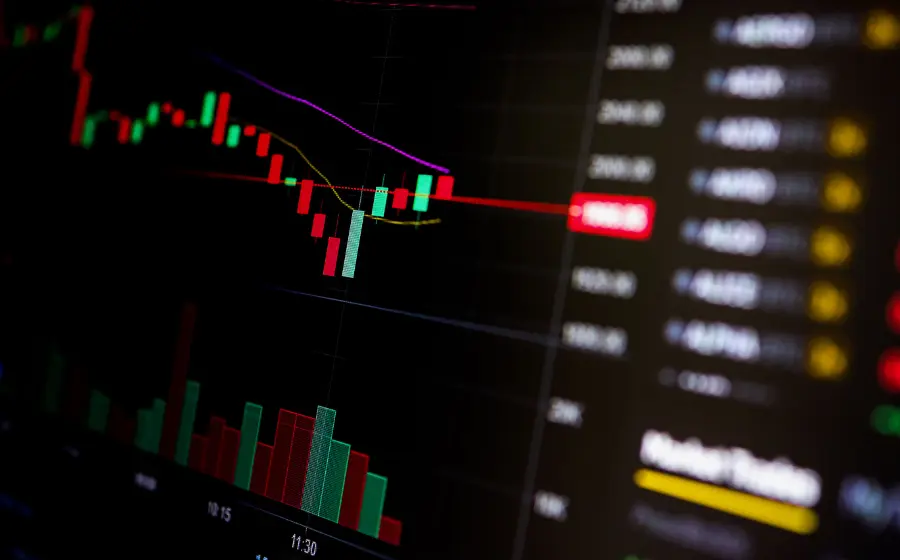
KEYTAKEAWAYS
- Understanding the interplay of macroeconomic factors, regulations, and investor sentiment is crucial for predicting market upswings.
- Historical patterns, like Bitcoin halving, offer some clues, but their impact is evolving as the market matures.
- Staying informed about major news and events, especially ETF approvals and policy changes, can help you anticipate market movements.

CONTENT
Discover the key factors influencing when crypto market will go up in 2024. Learn about Bitcoin halving events, ETF approvals, Federal Reserve policies, and more.
Crypto 2024 promises to be another exciting year. But how can you tell when crypto market will go up? CoinRank’s comprehensive article will delve into the key factors that drive market trends, from Bitcoin’s halving events and ETF approvals to Federal Reserve policies and the powerful FOMO effect.
A LOOK AT WHEN CRYPTO MARKET WILL GO UP: RECENT PERFORMANCE
Recently, the cryptocurrency market has shown volatile performance, particularly led by Bitcoin. Since the beginning of the year, Bitcoin (BTC) has surged approximately 69%, reaching a peak of $71,000. Despite some subsequent pullbacks, historical data suggest that this leading cryptocurrency has the potential to climb rapidly, possibly even surpassing the $140,000 mark.
According to Bloomberg, the 90-day correlation coefficient between Bitcoin and the Nasdaq 100 index has recently reached 0.46, highlighting its significant market influence. Additionally, although the Ethereum spot ETF has been approved, the actual launch date remains uncertain, creating some market unpredictability.
>>> Read More:
-
4 Key Factors Why Bitcoin Crosses $70K Again
-
Bitcoin Plunge: One Statistic Reveals Who’s Panicking and Who’s Not
3 FACTORS AFFECTING WHEN CRYPTO MARKET WILL GO UP
1. Inflation and Interest Rate Changes on the Market
Recently, the U.S. Department of Labor’s Consumer Price Index (CPI) has become a key factor in the reversal of the cryptocurrency market. Two weeks ago, market expectations for tightening policies had peaked, suggesting that any improvement in employment or price data, even if slightly below expectations, could trigger a rebound in cryptocurrency prices.
Indeed, the CPI indicated signs of slowing growth, with an annual increase rate of 3.5%, just 0.1% higher than the expected 3.4%. Although this difference is minimal, the market reacted positively, with most analysts interpreting it as confirmation of a continued decline in inflation growth.
For instance, on May 16, the latest CPI data showed a monthly increase of 0.3% and an annual increase of 3.4%, both below market expectations. This led the market to believe that U.S. inflation pressures were easing, boosting Bitcoin prices by 8% in a single day, from $61,000 to $66,000.
At the same time, Federal Reserve Chairman Powell emphasized in a meeting that the current rate of inflation decline was slower than expected and that the U.S. would maintain high interest rates for a while to curb inflation. These factors collectively spurred a rebound in the cryptocurrency market.
>>> Read More: The Impact of Uncontrolled U.S. Debt on Cryptos 2024
2. U.S. Presidential Election and Cryptocurrency Policy
Cryptocurrencies have become a significant issue in the U.S. presidential election for the first time. On May 9, former President Trump told cryptocurrency supporters at an event at Mar-a-Lago that they “better vote” for him because the Biden administration had imposed strict regulatory crackdowns on the industry. Trump stated, “They are against it,” and further elaborated on this stance while promoting his own NFTs.
As Trump accepted political donations in cryptocurrency, the influence of the crypto industry has grown. Cryptocurrency super PACs plan to spend over $80 million to influence Congress and ensure more favorable policy environments. Recently, the Democratic Party has shown signs of loosening its stance on cryptocurrencies, which may indicate growing political influence of the sector.
These political developments not only affect short-term market fluctuations but could also change the regulatory landscape for cryptocurrencies in the long run.
>>> Read More:
-
How the 2024 U.S. Presidential Election Could Shape the Future of Crypto
-
FIT21 Act: Regulatory Framework for the Future of U.S. Crypto
-
2024 U.S. Presidential Election Series
3. FOMO Effect Among Retail Investors
In the cryptocurrency market, FOMO, or “Fear of Missing Out,” is a powerful driving force. When the market sees significant price increases, investors often rush in, fearing they will miss out on potential profits, which further drives prices up.
In December 2017, Bitcoin reached its first historical high of around $20,000, largely driven by media coverage and public optimism about the future of cryptocurrencies. Stories of ordinary people becoming millionaires through Bitcoin investments fueled widespread FOMO, leading more people to enter the market and pushing prices even higher, showing when crypto market will go up.
Conversely, when negative news emerges, such as exchange hacks, increased government regulation, or technical vulnerabilities, these can trigger sell-offs and lead to price drops. For example, in 2018, a series of adverse events, including South Korea considering a ban on crypto trading and the Indian central bank preventing financial institutions from handling cryptocurrency transactions, severely dampened market sentiment and exacerbated the price declines of Bitcoin and other cryptocurrencies.
>>> Read More:
-
How Do We Choose a Qualified Crypto Exchange?
-
Crypto Market Crash – Stories Behind LUNA Crash and FTX Bankruptcy
HISTORICAL TRENDS AND MARKET DYNAMICS
1. Past Market Cycles and Bitcoin Halving
Over the past decade, the cryptocurrency market has gone through four bull and bear cycles, each closely related to Bitcoin’s halving events. Bitcoin halving is seen as a catalyst for major market movements, with halving cycles tightly linked to bull and bear market cycles.
Unlike previous bull markets, the current bull market has seen greater participation from institutional capital. The influence of institutional capital has gradually increased, making market narratives and capital flows more rational and concentrated. Additionally, Bitcoin’s volatility has decreased, with the market no longer dominated solely by retail investors. The lack of consensus among institutions has led to a phenomenon of non-participation and diversified narratives within the market.
The impact of Bitcoin’s quadrennial halving events on the market is gradually diminishing. Each bull market is increasingly driven by new market narratives and changes in the external environment. For example, the recent introduction of Bitcoin and Ethereum spot ETFs and changes in Federal Reserve policies have had a significant impact on the market. The future direction of the market will depend on these external and internal factors.
>>> Read More:
-
Why Has Bitcoin Surged Over 10,000%?
-
Bitcoin Halving 2024: Will It Be Different From the Previous Three?
-
Crypto Bull Market 2024: What It is and When to Buy
2. Crypto 2024 Major News and Events
Recently, several major news events have significantly impacted the cryptocurrency market. On May 24, the U.S. Securities and Exchange Commission (SEC) approved the 19B-4 form for the Ethereum spot ETF, but formal trading cannot begin until the S-1 form is approved, and the exact approval date is still unknown. This news caused short-term market fluctuations, but in the long run, it is expected to change the regulatory environment for cryptocurrencies.
Additionally, the approval of the Bitcoin ETF last year also had a profound impact on the market. Bitcoin prices reached an all-time high when the new spot ETF was introduced, but subsequently, there was a pullback. Such major news events often trigger the FOMO effect in the market, with investors rushing in for fear of missing out on potential profits, further driving prices up. However, as the market matures and institutional participation increases, the impact of these events on the market is becoming more rational.
Overall, recent major news and events show that the market is highly sensitive to changes in policies and products. Understanding these trends is key in identifying when crypto market will go up.
>>> Read More:
-
9 ETH Spot ETF Applications Under SEC Review
-
3 Major Implications and Legal Issues Following SEC Approval of Bitcoin ETFs in the U.S.
A WRAP-UP OF IDENTIFYING WHEN CRYPTO MARKET WILL GO UP
The rise of the cryptocurrency market hinges on several key factors, including Bitcoin’s halving events, ETF approvals, Federal Reserve policies, political developments, and the powerful FOMO effect among investors.
To navigate these waters, investors should keep a close watch on inflation data, interest rate changes, and major regulatory decisions. Staying alert to political changes that impact crypto regulations is also crucial.
While the allure of high returns in the crypto market is strong, it’s vital to diversify investments and focus on fundamentals to mitigate risks and achieve long-term success.
FAQ
- When will crypto market go up?
Market timing is difficult, but understanding key factors can help predict upswings.
- What factors affect when crypto market will rise?
Inflation, interest rates, regulations, political events, and investor sentiment all play a role.
- Does Bitcoin halving predict when crypto market will increase?
Historically, yes, but its influence is diminishing as the market matures.
- How do ETFs impact when crypto market will experience growth?
ETF approvals often boost confidence and can trigger price increases.
- Can FOMO predict when crypto market will surge?
FOMO can amplify existing trends, but it’s not a reliable predictor on its own.















